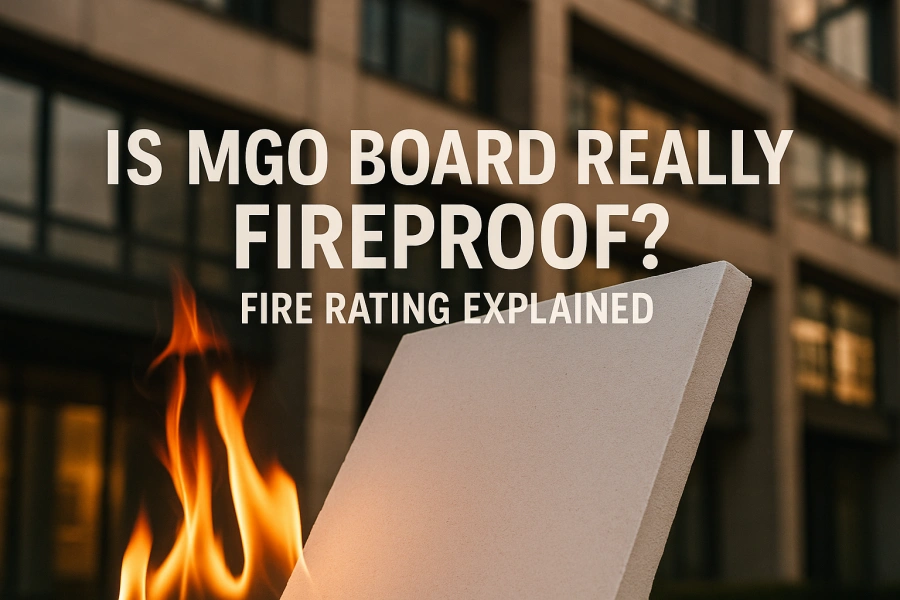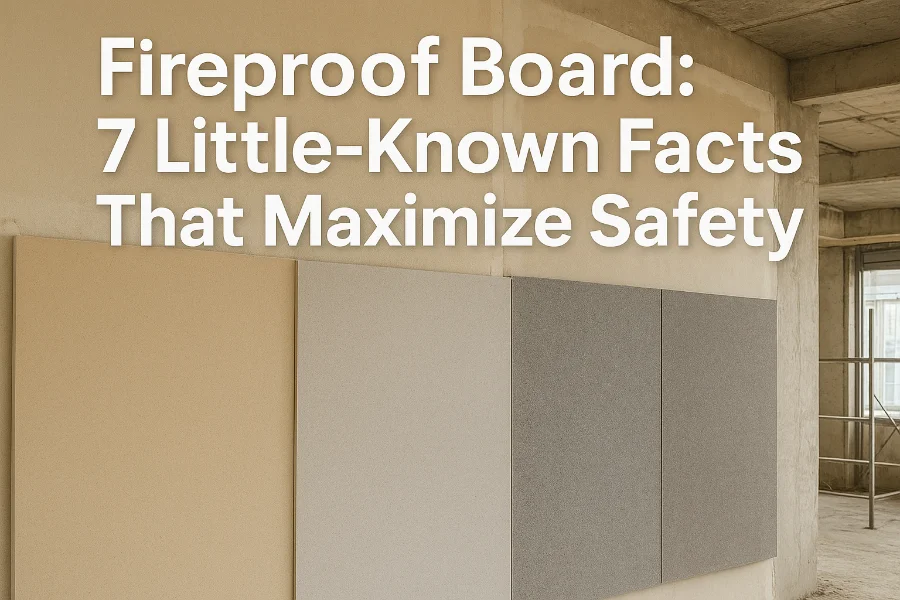Table of Contents
Ask Us Any Question
Introduction
Fire safety is a critical consideration in modern construction. Every year, buildings suffer from devastating fires that not only cause property damage but also endanger human lives. Choosing materials that can resist fire effectively is essential for architects, builders, and property owners. With the growing demand for safer construction solutions, questions about the fire performance of building materials have become increasingly important.
One material that has gained attention for its potential fire-resistant properties is MGO board—short for Magnesium Oxide board. But is it truly fireproof? Can it reliably slow down the spread of flames and withstand high temperatures? In this article, we will explore the fire rating and fire resistance of MGO board, explain the science behind its performance, and provide practical guidance for using it in construction projects.
By the end of this article, you will have a clear understanding of whether MGO board lives up to its reputation as a fire-safe building material and how to choose the right fire-rated board for your project.
What Is MGO Board?
MGO board, or Magnesium Oxide board, is a versatile, inorganic building material known for its durability, environmental friendliness, and fire-resistant properties. Unlike traditional gypsum or cement boards, MGO board is made primarily of magnesium oxide, magnesium sulfate, and reinforcing fibers, giving it a unique combination of strength, rigidity, and resistance to moisture and mold.
Its lightweight structure makes it easy to handle and install, while its strength allows for use in walls, ceilings, floors, and even exterior cladding. Architects and contractors appreciate its versatility, as it can be cut, drilled, and fastened without compromising its structural integrity.
One of the most compelling features of MGO board is its natural fire resistance. The inorganic composition means it does not burn, release toxic fumes, or emit excessive smoke when exposed to fire. This makes it an attractive option for applications where fire safety is a top priority, such as commercial buildings, schools, hospitals, and high-rise residential structures.
In addition to fire resistance, MGO board offers long-term durability against moisture, mold, and pests, which helps maintain the integrity of the structure over time. Its combination of safety, strength, and eco-friendly characteristics positions MGO board as a preferred material for modern construction projects where both performance and sustainability are valued.
Understanding Fire Rating vs Fire Resistance
When discussing the fire safety of building materials, it is crucial to understand the difference between fire rating and fire resistance, as the two terms are often used interchangeably but have distinct meanings.
What Is Fire Rating?
Fire rating refers to a standardized measurement of how a material reacts under fire conditions. It is usually determined by recognized tests such as ASTM E84, EN 13501, or local building code standards. Fire ratings categorize materials into classes, like Class A, B, or C, based on flame spread, smoke development, and heat release. For example, a Class A fire-rated material demonstrates minimal flame spread and low smoke generation, making it suitable for high-risk areas in residential and commercial buildings.
What Is Fire Resistance?
On the other hand, fire resistance measures the material’s ability to withstand fire exposure without structural failure over a certain period. While fire rating provides a standardized classification, fire resistance focuses on performance duration and thermal stability. A material with high fire resistance can maintain its integrity even when exposed to high temperatures for an extended time, providing occupants with crucial extra minutes to evacuate.
Importance for MGO Board
For MGO board, the distinction is important because it not only achieves a high fire rating but also offers exceptional fire resistance. This combination ensures that walls, ceilings, and partitions made of MGO board can slow down fire spread, maintain structural integrity, and enhance overall building safety. Understanding both concepts allows architects, builders, and property owners to make informed decisions when selecting materials for fire-safe construction.
How MGO Board Achieves Fire Resistance
Inorganic Composition
The remarkable fire resistance of MGO board is largely due to its inorganic composition. Magnesium oxide, the primary component, is naturally non-combustible, which means it does not ignite or support flame. Unlike gypsum boards that release water vapor and can deteriorate under high heat, MGO board maintains its structural integrity even under prolonged exposure to fire.
Reinforcement and Additives
Reinforcing fibers embedded in the board further enhance its strength and stability during high-temperature conditions. Some manufacturers also include additives that improve thermal performance, ensuring the board can withstand heat without warping, cracking, or producing harmful fumes. This makes MGO board a reliable choice for fire-rated applications in both commercial and residential buildings.
Installation Practices
Installation practices also contribute to fire resistance. Properly installed MGO boards, especially when layered or combined with fire-rated accessories like joint fillers and screws, can achieve high fire ratings such as Class A. This ensures that the material effectively slows down the spread of flames and limits smoke production, providing additional safety for occupants and property.
In practical terms, MGO board’s combination of fireproof composition, structural stability, and thermal resistance makes it superior to many conventional materials. Its proven performance under fire testing and its natural resistance to burning reinforce its position as a go-to material for fire-safe construction projects, giving architects and builders confidence in its protective capabilities.

Fire Rating Test Results of MGO Board
Standardized Fire Tests
MGO boards undergo rigorous testing to determine their fire rating and overall fire performance. Common standards include ASTM E84, which evaluates flame spread and smoke development, and EN 13501, a European standard that classifies building materials into fire safety categories. Many high-quality MGO boards achieve Class A fire rating, the highest level of flame resistance, indicating minimal flame spread and low smoke generation.
Comparison with Other Materials
Comparisons with other construction materials highlight MGO board’s advantages. Gypsum boards, while commonly used for fire protection, may lose integrity over time when exposed to moisture or sustained heat. Cement boards are non-combustible but are heavy and difficult to handle. MGO board strikes a balance, providing excellent fire performance while remaining lightweight and easy to install.
Real-World Applications
In addition to standardized tests, real-world applications confirm the material’s effectiveness. Buildings incorporating MGO board walls and ceilings report slower fire spread and reduced smoke hazards, which enhances occupant safety. The combination of lab-tested fire ratings and proven performance in practical scenarios makes MGO board a reliable solution for projects that require verified fire-resistant materials.
Architects and builders can use these test results to specify the appropriate board thickness and configuration for their projects. Whether for residential, commercial, or high-risk facilities, MGO board consistently delivers measurable fire safety benefits, aligning with regulatory standards and best practices in construction.
Why Fire Rating Matters in Construction
Compliance with Building Codes
Fire rating is more than a technical specification; it is a critical factor in ensuring safety, compliance, and long-term building performance. Building codes in many countries require materials used in walls, ceilings, and partitions to meet specific fire rating standards. Using materials that fail to meet these standards can lead to legal liabilities, increased insurance costs, and, most importantly, elevated risk to occupants during a fire emergency.
Occupant Safety
For MGO board, achieving a high fire rating translates into practical benefits on construction sites. Walls and ceilings constructed with fire-rated MGO board can slow the spread of flames, limit smoke production, and maintain structural integrity under high temperatures. This provides crucial extra minutes for evacuation and can significantly reduce property damage.
Specialized Applications
High fire-rated materials are particularly important in commercial buildings, schools, hospitals, and high-rise residential structures, where occupant density is high and evacuation may take longer. Fire rating also impacts material selection for specialized spaces such as data centers, laboratories, and industrial facilities, where fire risk is elevated.
Choosing MGO board for fire-rated construction not only ensures compliance with regulations but also reinforces a building’s overall safety strategy. Its combination of Class A fire rating and proven fire resistance makes it a reliable choice, giving architects, builders, and property owners confidence in their fire-safe design decisions.
Tips for Choosing the Right Fire-Rated MGO Board
Selecting the right fire-rated MGO board is essential to ensure both compliance with fire codes and optimal safety performance. Not all MGO boards are created equal, and careful consideration of certification, thickness, and installation can make a significant difference in fire resistance.
1. Check Certifications and Standards
Always verify that the MGO board has been tested under recognized standards such as ASTM E84, EN 13501, or local fire regulations. Official certification ensures that the board meets required fire rating criteria and performs as expected in real-world conditions.
2. Consider Board Thickness
Thicker boards generally provide longer fire resistance. For example, a 12mm MGO board may achieve a higher fire rating than thinner alternatives. Selecting the appropriate thickness for your project ensures adequate protection and regulatory compliance.
3. Evaluate Installation Practices
Proper installation is key to maximizing fire performance. Fire-rated accessories, joint fillers, and correct fastening methods all contribute to maintaining the board’s fire resistance. Improper installation can reduce effectiveness, even for high-quality boards.
4. Source from Reliable Suppliers
Choose manufacturers or distributors with a proven track record. Reputable suppliers provide documentation and guidance, ensuring consistency and quality in fire-rated MGO board products.
By following these tips, architects, builders, and property owners can confidently select MGO boards that deliver verified fire resistance, comply with building codes, and enhance overall fire safety in construction projects.
Conclusion
In summary, MGO board offers a compelling combination of fire resistance and certified fire rating, making it an excellent choice for fire-safe construction. Its inorganic composition, reinforced structure, and non-combustible properties allow it to maintain integrity under high temperatures, while its tested fire ratings provide assurance that it meets stringent building standards.
While no material can claim to be completely fireproof under extreme conditions, MGO board consistently demonstrates superior performance compared to many conventional materials. Its ability to slow down flame spread, limit smoke development, and withstand heat over time enhances both occupant safety and property protection.
For architects, builders, and property owners, understanding the difference between fire rating and fire resistance is essential. Selecting a certified, properly installed MGO board ensures compliance with local building codes and contributes to a reliable fire safety strategy.
Ultimately, the question posed at the beginning—“Is MGO board really fireproof?”—can be answered with confidence: while absolute fireproofing is impossible, MGO board achieves one of the highest levels of fire safety available in modern building materials. Its proven fire performance, versatility, and environmental benefits make it a top choice for projects where fire safety cannot be compromised.
FAQs
1. What is the fire rating of standard MGO board?
Standard MGO boards often achieve a Class A fire rating, indicating minimal flame spread and low smoke development. The exact rating may vary depending on thickness, manufacturer, and certification standard (ASTM, EN, or local). Using certified MGO boards ensures compliance with building codes and provides reliable fire resistance for walls, ceilings, and partitions.
2. How long can MGO board resist fire?
MGO board can withstand high temperatures for extended periods, typically 60–120 minutes depending on thickness and installation. Its fire resistance allows structural integrity to be maintained while slowing down flame spread, giving occupants additional time to evacuate safely during a fire.
3. Is MGO board better than gypsum board in fire resistance?
Yes. While gypsum boards have fire-resistant properties, MGO board generally performs better due to its inorganic composition, higher thermal stability, and resistance to moisture. This makes it more reliable for long-term fire-safe construction.
4. Can MGO board be used in high-risk fire areas?
Absolutely. MGO board’s combination of high fire rating and proven fire resistance makes it suitable for high-risk areas, including commercial buildings, schools, hospitals, and industrial facilities. Proper installation and certification further ensure maximum fire safety.
How to choose a reliable MGO board supplier: discover key merits of suppliers and magnesium oxide boards for safe, durable, and eco-friendly construction.
Discover 7 key benefits of magnesium oxide wall panels for modern homes, from fire resistance and moisture protection to durability and eco-friendliness.
Discover 7 little-known facts about fireproof boards that enhance safety, durability, and versatility. Learn how to protect buildings effectively.




